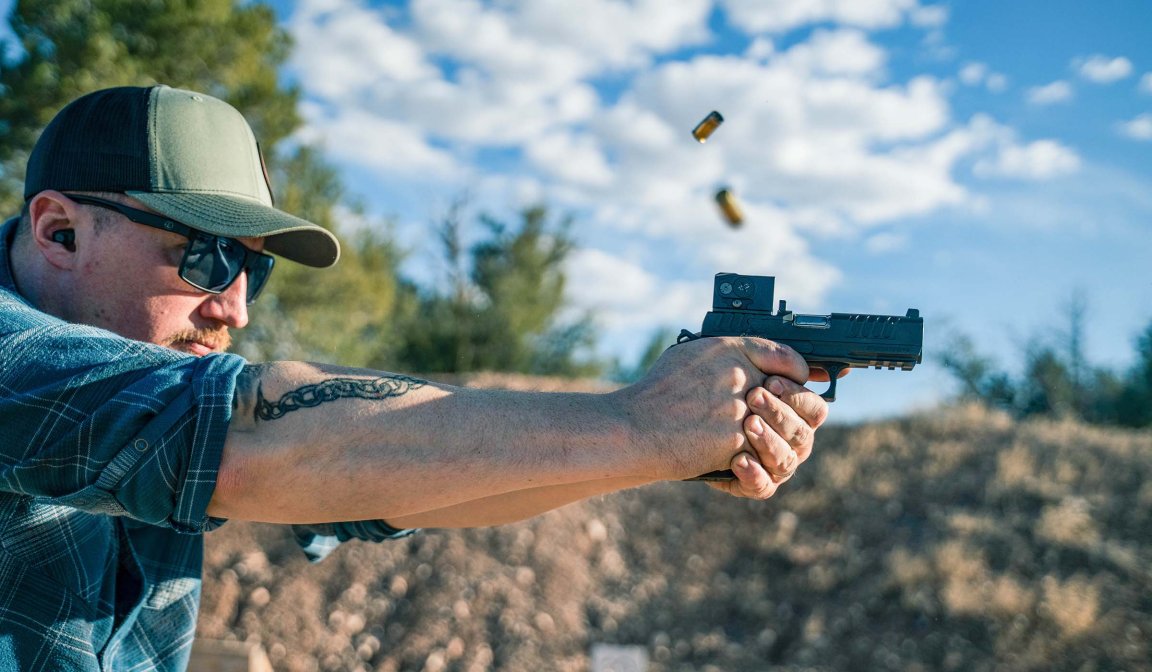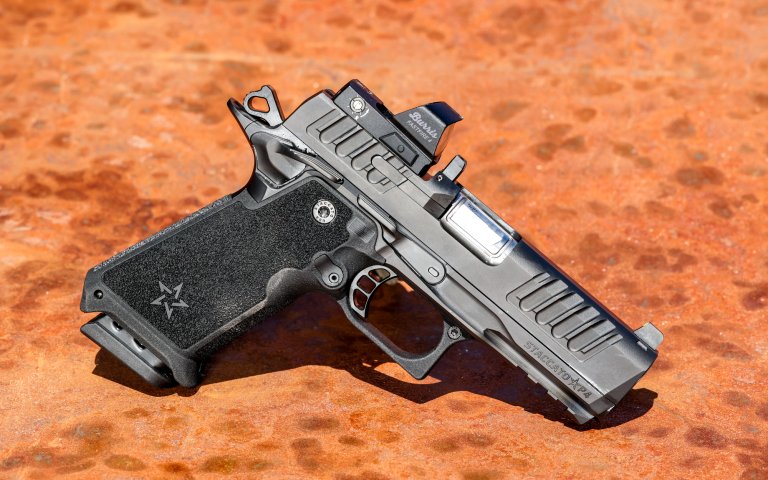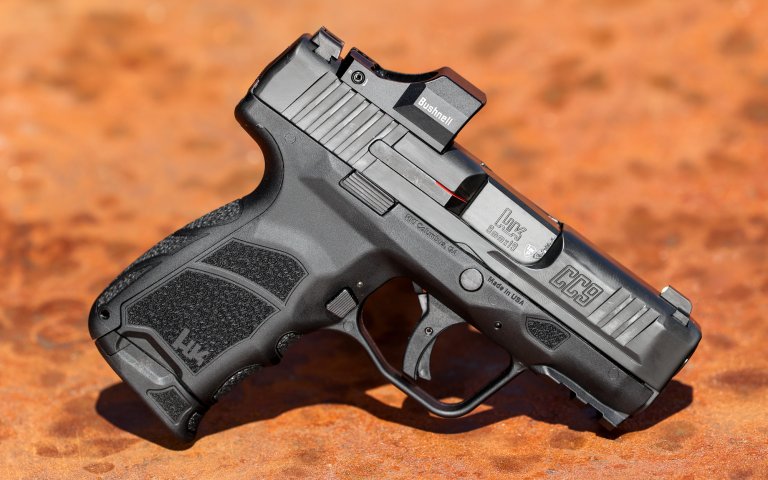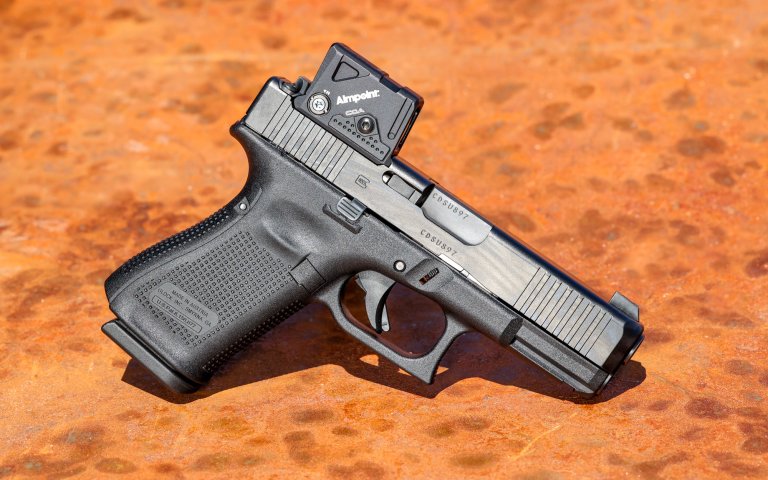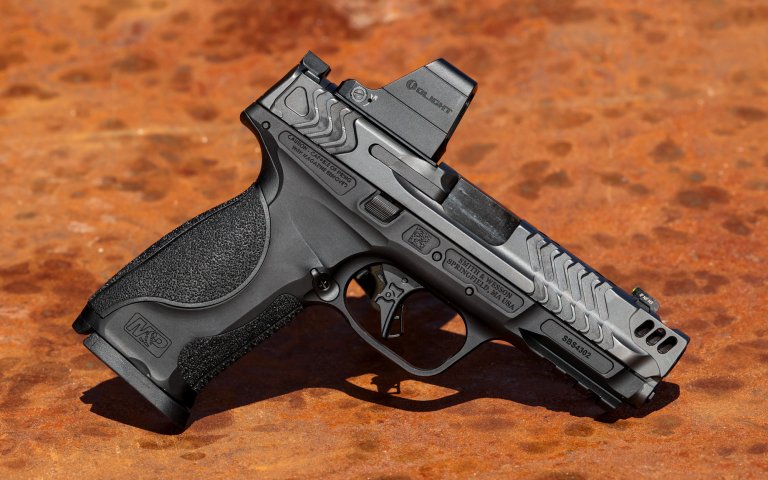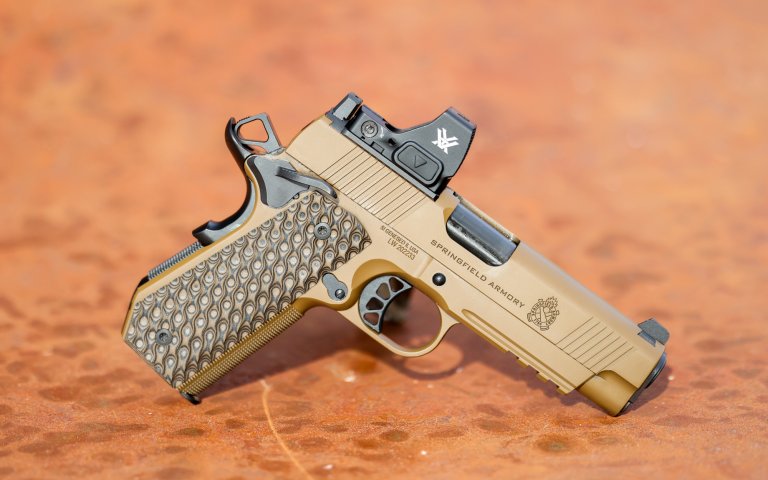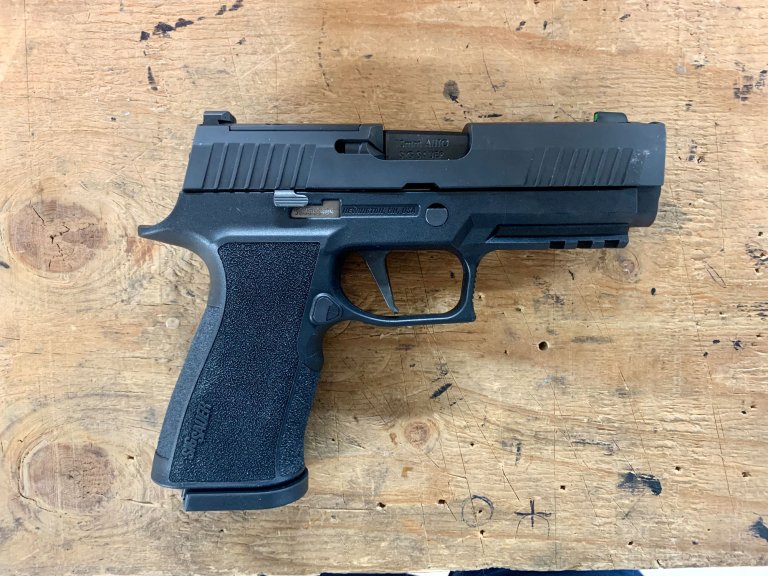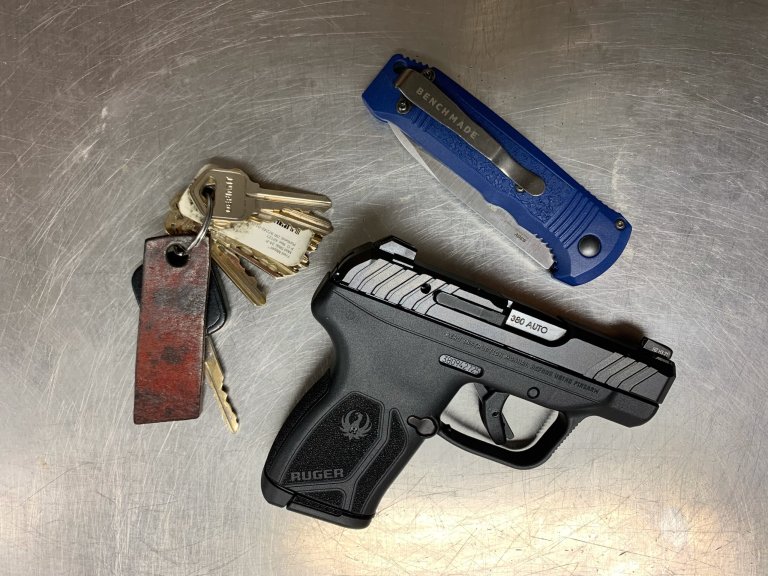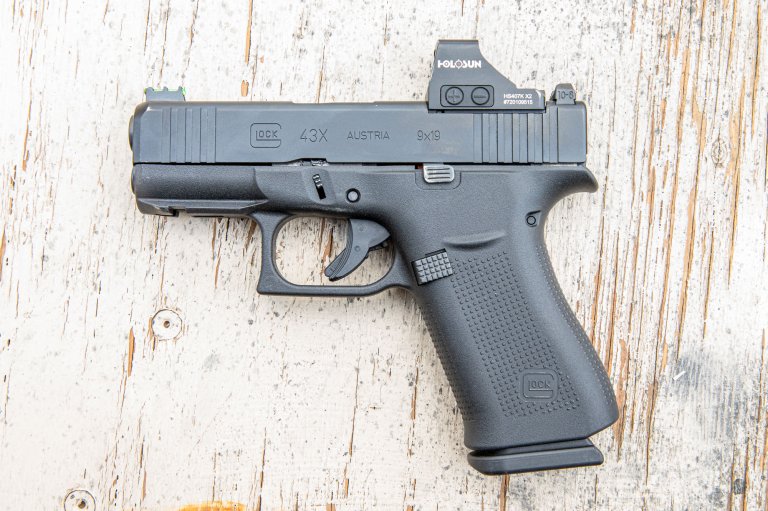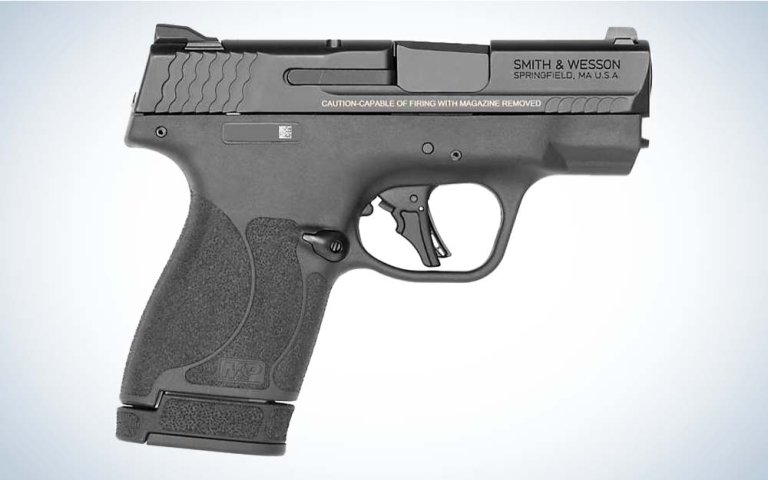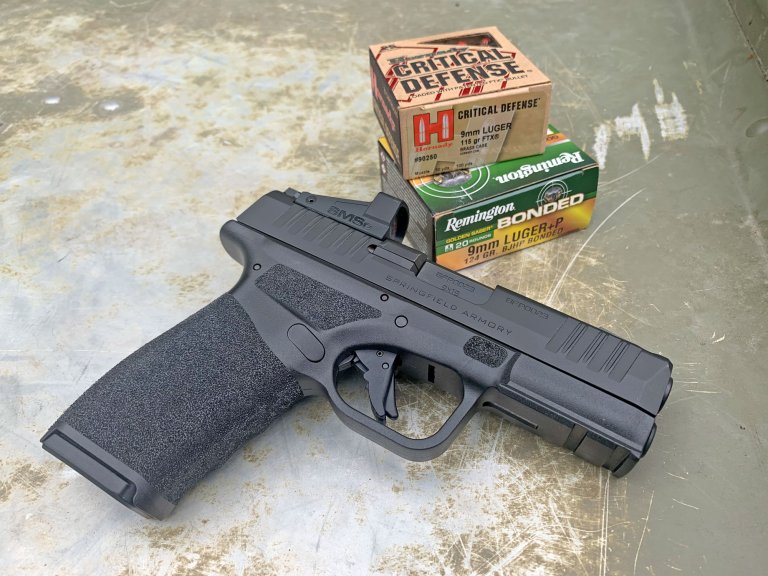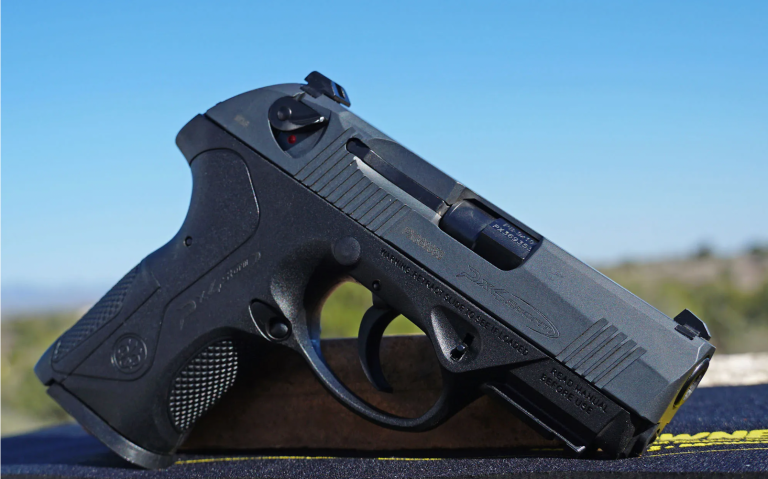We may earn revenue from the products available on this page and participate in affiliate programs. Learn More ›
Testing the best handguns of the year is one of the projects we look forward to most at Outdoor Life, and this season’s crop of new pistols didn’t disappoint. Though the field of new handguns is modest in size, it covers a lot of ground. The mix includes high-end pistols for fast and fancy shooting, an excellent new entry in the concealed-carry market, an innovative optics-mounting system, and an appealing budget semi-auto, among others.
We judge these pistols on their accuracy, durability, ergonomics, value, and other qualities during a multi-day torture test where we shoot the snot out of them. Once again, Gunsite Academy was our home for this evaluation – it is a perfect venue for this kind of work.
Best New Handguns of 2025
- Editor’s Choice, Best Overall: Staccato P4
- Editor’s Choice, Best Concealed Carry: HK CC9
- Great Buy: Ruger RXM
The stars of this year’s test included these standouts. The Staccato P4, an innovative double-stack 9mm that improves on the company’s high-quality 2011s, earned an Editor’s Choice award as overall best handgun of the year. Ruger’s RMX, a Glock 19 Gen3 clone launched in conjunction with Magpul, is a screaming deal for the price and walked off with Great Buy honors. And the new HK CC9 won an Editor’s Choice award as the best concealed carry handgun of 2025.

Other Noteworthy Handguns
- Glock G19 Aimpoint
- OA Defense 2311 Pro Elite
- S&W M&P 2.0 Carry Comp
- Springfield 1911 TRP AOS CC
- Sig Sauer P320 XTen Comp
- Sig Sauer P365 XMacro Tacops
- Ruger LCP Max
- Glock G43X
- Smith & Wesson Shield Plus
- Springfield Armory Hellcat Pro Comp
- Beretta PX4 Storm Compact Carry 2
There were many other appealing pistols in the test. We all had high praise for the soft-shooting Smith & Wesson M&P 2.0 Carry Comp. Springfield’s 1911 TRP AOS CC Pistol is a well-mannered single-stack 9mm that grew on us the more we shot it. And Glock’s collaboration with Aimpoint’s new COA “A-Cut” optic is a game-changer — the way the optic connects to the pistol is likely to become a new industry standard.
This story also includes other handguns we’re particularly fond of and is a useful guide for anyone looking to acquire one, whether for personal protection, competition, general plinking, or back-country/bear defense. See our review of the best handguns of 2024, here.
Best Handguns of 2025: Reviews & Recommendations
Editor’s Choice, Best Overall: Staccato HD P4
Pros
- Flat-shooting, accurate
- Excellent grip texture
- Uses more affordable magazines
Cons
- Expensive
Specs
- Cartridge: 9mm
- Capacity: 18+1
- Barrel Length: 4 inches
- Weight: 35 ounces (with empty magazine)
- Price: $2,499
Key Features
- Uses Glock pattern magazines
- Eliminates grip safety

When it comes to building fine production semi-autos, few companies can match Staccato’s track record. Their 2011 double-stack pistols are the top pick for many competitors, military and LE professionals, and shooters who have an eye for the finer things in life.
The Staccato P4 is a new design from the company that incorporates many innovations. Notably, it takes Glock 17/47 pattern magazines, replacing the expensive, and often finicky, legacy 2011 bottleneck mags. It also has an optics mounting system that uses thin shims to attach red dots directly to the slide. This positions the optics lower and, based on our testing, is much more secure. The other big change is ditching the 1911-style grip safety, which is a nice upgrade.
It shot very well for us, being both fast and accurate. The ambidextrous controls are slick and intuitive and everything on the gun — from the comfortable and secure stippling on the grip, to the crisp trigger, to the simplified recoil system — is well thought out.
The gun is also quite durable. The test team ran it nearly nonstop during the week of our evaluation, putting God knows how many rounds through it, but it never had any failures or stoppages. All this added up to the P4 being our consensus pick for the Editor’s Choice award as overall best handgun of 2025.
For a more detailed look at this appealing 9mm, check out Senior Staff Writer Tyler Freel’s review. Note that a 4.5-inch barreled variant (called the P4.5) will be launching soon, and if you fancy Staccato’s vibe we also suggest you check out the Staccato P, Staccato C, and Staccato CS, which we also like and recommend.
Editor’s Choice, Best Concealed Carry: HK CC9
Pros
- Light and easy to conceal
- Comfortable to shoot
- Reliable
Cons
- Long trigger pull
Specs
- Cartridge: 9mm
- Capacity: 10+1 or 12+1
- Barrel Length: 3.32 inches
- Weight: 20 ounces
- Price: $699
Key Features
- Ships with two magazines (12-round and 10-rounds)
- Cut for RMSc optics
- DLC finished slide
Last September, Hecker & Koch announced the creation of HK-USA, based in Columbus, Georgia, with the promise to launch several new products designed and built in the United States in 2025. The HK CC9 is the first of those and I’m happy to report that it sets the bar pretty high for whatever HK-USA has next in store.
This micro 9mm, optimized for concealed carry (hence CC9) checks all the boxes we look for in a sub-compact carry gun. Its striker-fired system is easy to operate. The shape of the grip and its light texture pattern offer enough purchase for the shooter’s hands without being snaggy. The slide has an optics cut for RMSc-pattern dots and the frame incorporates a two-slot Pic rail under the dust cover for accessories. The controls, including the ambidextrous magazine release, operate in a positive manner, yet have a low profile.
The geometry of the CC9 deserves special mention. The pistol is radiused all around (other than the front of the pic rail) to minimize hanging up on holsters or clothing. The rear of the trigger guard and the beavertail are both cut high so the pistol sits low in the hand, mitigating muzzle flip. The frame is fairly narrow to enhance the pistol’s ability to be concealed. And you can customize the length of pull with interchangeable backstraps.
We felt the trigger stroke was a bit long, and every now and then the slide wouldn’t lock open on an empty magazine but, other than that, we had no serious criticisms.
We loved that the pistol handled every type of ammo we put through it and we found it to be eminently shootable even with +P ammo, which isn’t a given for this category. Considering the feature set and how it shoots, it is also a good value. It’s clear that HK-USA did its homework with the CC9 and it went home with a well-deserved Editor’s Choice as the best handgun for concealed carry.
Great Buy: Ruger RXM
Pros
- Comes with high-quality open sights
- Compatible with RMR, Delta Point, and RMSc red dots
- Good grip ergonomics
Cons
- The Magpul magazines it shipped with had trouble feeding the last round. This issue went away when other Glock magazines were employed.
Specs
- Cartridge: 9mm
- Capacity: 15+1
- Barrel Length: 4 inches
- Weight: 23 ounces
- Price: $499
Key Features
- Removable fire-control system
- Compatible with G19 Gen3 aftermarket parts
- Uses grip modules designed by Magpul
Ruger has jumped into the Glock clone market with the RXM, done in collaboration with Magpul, which designed and manufactured the grip module. I don’t think I’m going out on a limb by predicting that this G19 Gen3 knockoff will be a big hit. Whether a user keeps it in stock form or opts to modify it with any of the innumerable aftermarket parts that exist for Gen3 Glocks, it represents a tremendous value.
There isn’t a lot to say about how it operates — it shoots like a G19, with the same predictable reliability the pistol is known for. In terms of looks and feel, the Magpul grip is more attractive than the original and has improved stippling and ergonomics. The slide sports quality metal sights, a marked improvement over stock Glock sights. The front post has a tritium insert and they are tall enough to co-witness through a reflex sight. Touches like the stippled contact patch on the chassis above the trigger guard elevate it above the pistol it is patterned after.
Also, unlike the original G19, the RXM has a removable fire-control system (which is serialized) made of stainless steel that can be swapped into other grip modules. Currently, Magpul is offering their modules in different colors, but we look forward to seeing PCC modules and other designs that leverage the RXMs flexibility.
Despite this fire-control system, the RXM is compatible with aftermarket Glock triggers, as well as barrels, holsters and all the other gizmos that have been designed for the Gen3 G19s.
The slide’s optics cut has holes that accept RMR, Delta Point Pro, and RMSc red dots, another value-enhancing feature.
In short, the RXM does the G19 Gen3 better in many respects, at a better price. This pistol was a no-brainer as this year’s Great Buy in the handgun category.
Glock G19 with Aimpoint COA
Pros
- Much improved optics mounting system
- Able to co-witness with standard-height sights
- Traditional Glock reliability
Cons
- No major drawbacks
Specs
- Cartridge: 9mm
- Capacity: 15+1
- Barrel Length: 4.02 inches
- Weight: 24 ounces
- Price: $1165
Key Features
- Innovative “A-Cut” optic pattern
- Fixed sights co-witness through Aimpoint COA red dot
- Available in five Glock models

While the pistols resulting from Glock’s collaboration with Aimpoint are new, the partnership is more about the optic — specifically about how it attaches to the slide.
The Aimpoint COA was designed for, and is exclusive to, Glock for the remainder of this year. This enclosed emitter red dot is available on five models — the G43X, G48, G45, G47, and the G19 Gen5 we tested.
The sight fits into the slide like a ski boot going into a binding. A lip on the front of the optic goes into a corresponding cut, while the pistol’s rear sight, which connects to the slide with two fasteners, pins the back of the optic in place for a rock-solid connection.
This looks to be a stronger and more elegant way to attach a red dot to a pistol, significantly reducing the shear force the fasteners experience and allowing the sight to sit deep within the slide. In turn, this allows the standard-height open sights to be usable through the red dot if needed.
I expect this A-Cut pattern to become an industry standard, especially for compact carry guns.
We experienced zero issues with this pistol and red dot and enjoyed shooting it during our evaluation. As expected, the G19 Gen5 functioned flawlessly, embodying everything we know and love (or not) about the world’s most popular striker-fired pistol.
Other handgun makers are champing at the bit to put the COA on their guns, but Aimpoint is obligated to work with Glock exclusively through the remainder of 2025 so don’t expect to see it on other pistols — or on sale as an individual product — until after we ring in 2026.
For a deeper look at the Glock/Aimpoint collaboration, see Freel’s review on his G48. Also, if you don’t care to throw down for the cost of the pistol and optic combo, check out the regular G19s, which are also among our favorite handguns.
OA Defense 2311 Pro Elite
Pros
- Flat shooting
- Crisp trigger
- Uses common Sig P320-pattern mags
Cons
- Expensive
Specs
- Cartridge: 9mm
- Capacity: 21+1 or 17+1
- Barrel Length: 5 inches
- Weight: 33 ounces
- Price: $3,149
Key Features
- Takes 21-round magazines
- Interchangeable thumb ledges on both sides of frame
- Ported 5-inch barrel
- Comes with five magazines
This double stack 9mm 1911 variant is a showy piece that makes a big visual statement and is also a hoot to shoot. We’ve had good experiences with OA Defense’s handguns in the past (the OA 2311 Compact Pro for example) and the 2311 Pro’s providence is easy to see.
Our Gen Z videographer fell in love with the pistol, and perhaps the 2311 Pro will strongly appeal to shooters who want a tactically inspired blaster with some drip.
The older shooters on the squad — that is to say those of us who were actually testing the gun — didn’t fall as readily under its sway. While the pistol can put a lot of lead on target in mere seconds, and is enjoyable to run, we thought aspects of it could be improved with a “less is more” approach.
For instance, the oversized controls and hyper aggressive grip texture would benefit from being toned down. The mag release button sticks up so high that the 2311 Pro cannot be shot with the “wrong” hand for fear of releasing the magazine in the midst of a shot string. While the catch can be reversed, there are many shooters who prefer to keep the catch on the side where their trigger finger depresses it – and for them this pistol won’t work.
There’s a lot to like about the pistol, however. The trigger is crisp, the action is slick, and the compensated barrel and overall heft of the gun make it a flat shooter. Another thoughtful touch is the smooth underside of the trigger guard which includes contours for the index finger of the support hand.
We have no doubt there are many people out there who would be happy owning one and with a bit of refinement this futuristic-looking pistol would have even broader appeal.
S&W M&P 2.0 Metal Carry Comp
Pros
- Crisp trigger
- Flat shooting
- Accurate
Cons
- Full-sized aluminum frame adds weight
Specs
- Cartridge: 9mm
- Capacity: 17+1
- Barrel Length: 4.22 inches
- Weight: 28.1 ounces
- Price: $999
Key Features
- Aluminum frame
- Optics ready
- Barrel compensator
This pistol was the sleeper of the test. At first glance, it would be easy to dismiss it as just another metal-framed option for a polymer pistol, but that would be a mistake. After spending a week shooting it, we came away impressed with this capable full-sized 9mm.
The team of judges all appreciated the M&P 2.0 Metal Carry Comp’s balance. And we mean that in the broadest sense. The pistol is a mild-mannered shooter that manages recoil well thanks to its “Power Port” compensator, aluminum frame, and overall heft that is neither too heavy nor too light.
The grip has a fine sandpaper-like stippling that isn’t too rough yet provides the gripping hand a lot of support. And the cocking serrations in the slide, while aggressive, aren’t sharp or uncomfortable in the least. Like we said, balanced.

The pistol is optics ready, has a pleasant trigger, reversible mag catch, and ambidextrous slide lock levers. It also comes with replaceable backstraps to fine tune the grip and ships with two 17-round magazines. Though designed for defensive carry, at 1 pound, 12 ounces it is somewhat hefty, but that bulk is what makes it a pleasure to shoot at the range.
Springfield 1911 TRP AOS CC
Pros
- Great accuracy
- Good trigger
- Versatile optic cut
Cons
- Erratic ejection
- Limited 9+1 capacity
Specs
- Cartridge: 9mm
- Capacity: 9+1
- Barrel Length: 4.25 inches
- Weight: 31 ounces
- Price: $1,897
Key Features
- Ambidextrous safety levers
- Concealed carry frame contour
- Single-stack magazine
- Agency Optics adapter plates
We’ve grown so used to double-stack semi-autos that hold cartridges sufficient for a week’s worth of shooting that it is easy to sniff at a single-stack 1911 style pistol like this Springfield. And a frequent refrain during our testing with the TPR AOS CC — at least in the beginning — was that it was a nice gun but just didn’t hold enough bullets.
We soon changed our tune, however. This sleek 9mm delivered impressive accuracy, and the aggressive grip, which we initially feared was too much of a good thing, grew on us the more we shot.
The safety lever on ours started a bit stiff but after a day’s worth of shooting that smoothed out too.
The TRP — for Tactical Response Pistol — is a comfortable, easy shooter. This Commander-sized gun has a generous beavertail, narrow grip, and deep optics cut that enhance its fine handling. As a lefty, I appreciated the ambidextrous safety which worked well for me. In fact, all the controls on the pistol are smooth to operate.
Tyler Freel published an in-depth review that is worth your time if a single-stack 9mm is on your bingo card.
Other Best Handguns We’ve Tested and Recommend
Sig Sauer P320 XTen Comp
Pros
- Soft shooting
- Accurate (1.6 inch 5-shot groups at 15 yards)
- Easy to Carry
Cons
- No major downsides
Specs
- Cartridge: 10mm Auto
- Capacity: 15+1
- Barrel Length: 3.8 inches
- Weight: 32 ounces
- Price: $950
Key Features
- Compensator
- Delta Point optics cut
- Ambidextrous design
This pistol immediately caught our attention when it launched not long ago. Senior Staff Writer Tyler Freel and I both spend a lot of time in bear country so whenever a new 10mm crops up we are eager to test it out.
We both agreed that this compensated pistol is the softest-shooting compact 10mm we’ve handled. That, along with its good accuracy and reliability after putting hundreds of rounds through our samples earned it an Editor’s Choice award in 2024 as the best handgun for backcountry carry.

We published an in-depth review of the pistol and did a video comparing it to the Glock G20, but highlights include its compact dimensions for ease of carry, solid 15+1 magazine capacity, effective compensator, and reasonable price.
Sig Sauer P365 XMacro Tacops
Pros
- Soft shooting
- Trimmer than other pistols in its class
- Reliable
Cons
- No major drawbacks
Specs
- Cartridge: 9mm
- Capacity: 17+1
- Barrel Length: 3.7 inches
- Weight: 23 ounces
- Price: $800
Key Features
- Takes 17-round magazines
- Modular grip backstraps to adjust fit
- Cut for Romeo Zero/Shield RMS optics
Picking a single Sig P365 to highlight is no easy task — there are many good options in this family of sub-compact and compact pistols from which to choose. That said, the XMacro Tacops is one of our favorites for many reasons but mostly for how it maximizes the potential of the P365 platform.
The XMacro Tacops, thanks to its larger grip module, can accommodate 17-round magazines (the pistol thoughtfully ships with four of them), and it has a flared mag well to make inserting them easier.
Other appealing features include a cut in the slide for an optic and a three-slot accessory rail up front for adding a light or laser.
The pistol has fine ergonomics, shoots well, and is trim enough to conceal easily — though should you want a smaller handgun the standard P365 is a good choice too.
Ruger LCP Max
Pros
- Easy to conceal
- Affordable
- Easy to manage recoil
Cons
- Limited accuracy
Specs
- Cartridge: .380 Auto
- Capacity: 10 or 12 rounds
- Barrel Length: 2.8 inches
- Weight: 10.6 ounces
- Price: $366
Key Features
- Has 10- and 12-round magazines
- Small size for maximum concealability
If you’re looking for maximum concealability in a carry gun while sacrificing as little as possible in terms of potency and magazine capacity, then the Ruger LCP Max is worth a look. In the world of pocket pistols, this little guy makes the most of what it’s got.
While weighing in under 11 ounces, this Ruger can fit 10 rounds of .380 Auto into its magazine — or 12 rounds with the larger mag with the finger extension.
It also comes with a reasonable pair of fixed sights, though as with any pistol this size don’t expect amazing accuracy beyond seven yards.
Another nice thing about the Ruger LCP Max is its price. It won’t break the bank, so as a backup gun or for deep concealment it is cheap insurance.
Glock G43X
Pros
- Balanced micro 9
- Shoots well
- Affordable
Cons
- Slightly less capacity than many other micro 9mm pistols
Specs
- Cartridge: 9mm
- Capacity: 10+1
- Barrel Length: 3.39 inches
- Weight: 16.4 ounces
- Price: $450
Key Features
- 10 round 9mm in a sub-compact frame
- Striker fired
The Glock G43X is an upsized version of the G43 with a larger grip and boosted round count. While shooters value concealability, there’s little question that they like magazine capacity even more, and the G43X is Glock’s effort to give their customers the best of both worlds.
There’s nothing surprising about this pistol. It feels and shoots like a Glock and strikes a nice balance between firepower, ease of concealment, and shootability.
This handgun runs with the dependable predictability we associate with these Austrian-made striker-fired semis, which added to its good ergonomics and attainable price makes it one of the best concealed carry guns out there.
Smith & Wesson Shield Plus
Pros
- Good magazine capacity
- Easy to carry
Cons
- Extended mag leaves a gap between it and the grip
Specs
- Cartridge: 9mm
- Capacity: 13+1
- Barrel Length: 3.1 inches
- Weight: 19.3 ounces
- Price: $550
Key Features
- Optics ready
- 13- and 10-round magazines
This is a handy micro 9mm pistol that is one of the better shooters in the category. The Shield Plus has good grip texture on the frame and its flat-faced trigger is one of the best among value-priced striker-fired pistols of this size.
You have the choice of running it with a flush-fit 10-round magazine or bumping up capacity to 13 rounds with the included extended magazine. The larger magazine gives support to your pinkie without adding much height to the pistol, but for maximum concealability the 10-round is better.
This model comes with an optics cut, though you can get a Shield Plus without the cut for about $50 less if you just want open sights.
Springfield Armory Hellcat Pro Comp
Pros
- Flat shooting
- Excellent recoil management
- Optics ready
Cons
- Heavy trigger
Specs
- Cartridge: 9mm
- Capacity: 15+1 or 17+1
- Barrel Length: 3.7 inches
- Weight: 20 ounces (with optic)
- Price: $600
Key Features
- Excellent magazine capacity
- Integral compensator
No other company energized the micro-9 category like Springfield. The original Hellcat was a ground-breaking pistol that upped the ante for firepower in a small package. Springfield has gone on to introduce many variants of the Hellcat including the Hellcat Pro Comp, which is one of our favorites. (Check out our full review for more.)
Put simply, this pistol has everything one needs in a carry gun. Its feature set includes an optics cut on the slide for RMSc red dots, an accessory rail for lasers or lights, impressive magazine capacity, and the most effective compensator we’ve seen on a pistol in this category.

About the only thing we’d like to see changed is the trigger, which is heavier than it needs to be. Address that and you’d have a nearly perfect carry gun at an appealing price.
Beretta PX4 Storm Compact Carry 2
Pros
- Soft recoil impulse
- Accurate
Cons
- Heavy
Specs
- Cartridge: 9mm
- Capacity: 15+1
- Barrel Length: 3.2 inches
- Weight: 27.3 ounces
- Price: $889
Key Features
- DA/SA Action
- Bobbed hammer
- Rotating barrel
This handgun has the distinction of being the only DA/SA pistol in this roundup. The DA/SA format has dipped in popularity with the general shooting public — some people find the first double-action trigger pull to be distracting and heavy before the lighter single-action trigger break takes effect — but it still has its place, and the PX4 Storm Compact Carry 2 is one where it makes sense.
To enhance the Storm’s concealability, Beretta built it with a bobbed hammer that sits flush within the slide. That also limits the debris that might be able to work its way into the pistol.
The first trigger pull is stiff, but not unduly so. And in single-action mode the break is crisp and light.
This pistol is a soft shooter and handles recoil very well — but the heavy slide that makes that possible adds weight to the gun and gives it a recoil impulse that some people love while others don’t care for it.
Nonetheless, this is an excellent option for a quality concealed-carry handgun that gets away from the striker-fired systems that dominate the market.
How We Test Handguns

To determine the year’s best handguns we assembled our panel of judges and headed to Gunsite Academy in Paulden, Arizona, for a week’s worth of shooting. In addition to yours truly, the test team included Executive Editor Natalie Krebs, Senior Staff Writer Tyler Freel, and a trio of excellent pistoleres — Sean Murphy, Matt Foster, and Chris Gittings.
Together we put hundreds of rounds through each handgun, accessing them on numerous qualities including ergonomics, workmanship, accuracy, handling, reliability, and value. During the shooting we’ll shoot them for groups at 15 yards with match ammo, we run them rapidly on arrays of steel and set drills like the Bill Drill, and we’ll even step back to the 50-yard-line and see how they fare at longer distances.
During this process we go over each gun with a practiced eye and take note of their good qualities and their flaws. We then score the handguns independently in 10 different categories and tally the results in a spreadsheet. The handguns with the highest scores in their category earn the Editor’s Choice award, and the handgun with the highest value score earns the Great Buy.
There’s no favoritism in this process — we don’t shade our results to appease any advertiser as so often happens — and as a result this is the most honest and rigorous handgun test out there.
Final Thoughts on the Best Handguns
As much as anything else this field of new pistols demonstrates the scope of creative energy in the handgun market. We have Staccato taking their excellent 2011 platform and making it more user friendly by adopting Glock-pattern magazines and other upgrades; HK-USA coming out with a banger concealed-carry 9mm for their first offering; Ruger upping the bar for value and performance with their RXM Glock Gen3 clone; and Glock working with Aimpoint to improve how red dots connect to pistols.
For handgun enthusiasts these are good times, with lots of intriguing options for different pursuits — often at appealing prices. Year in and year out, the best handguns just keep getting better.
